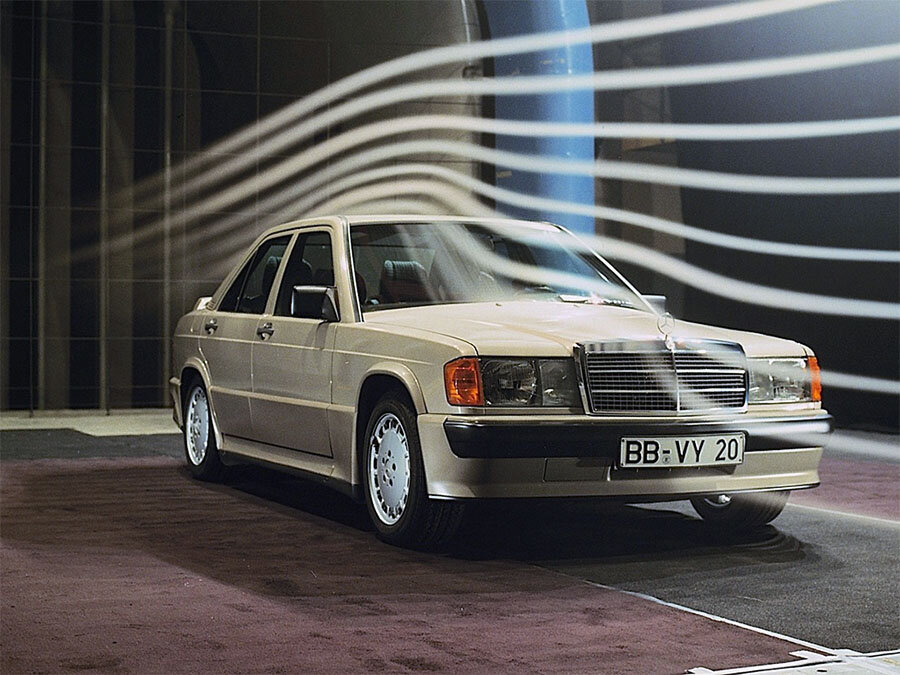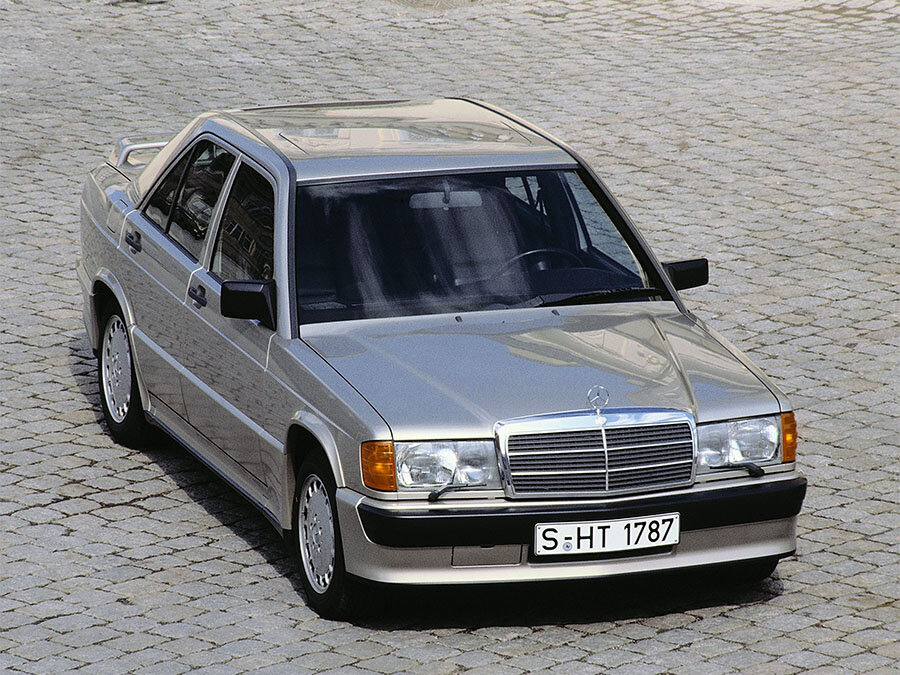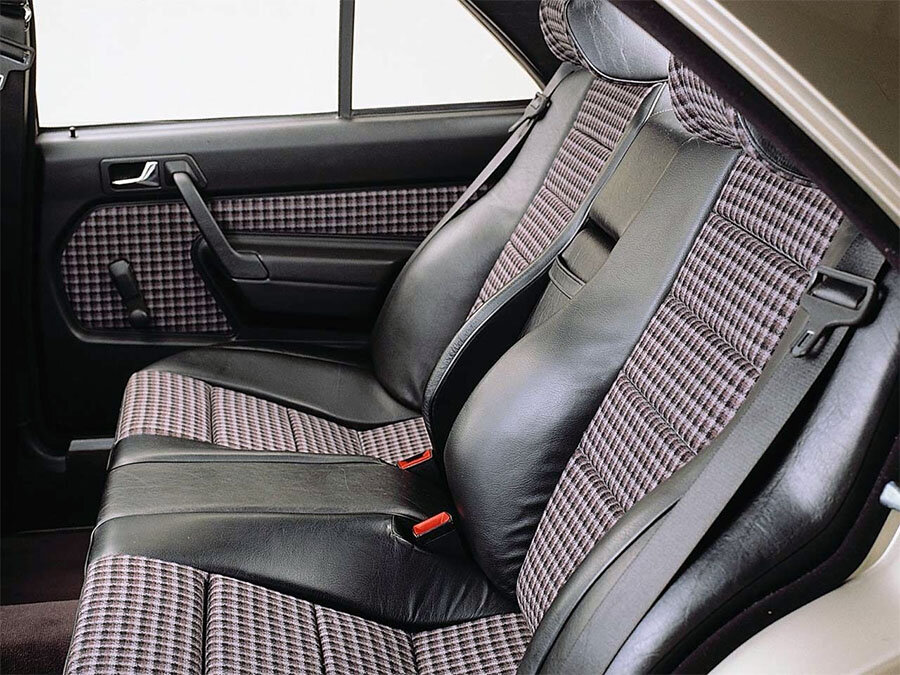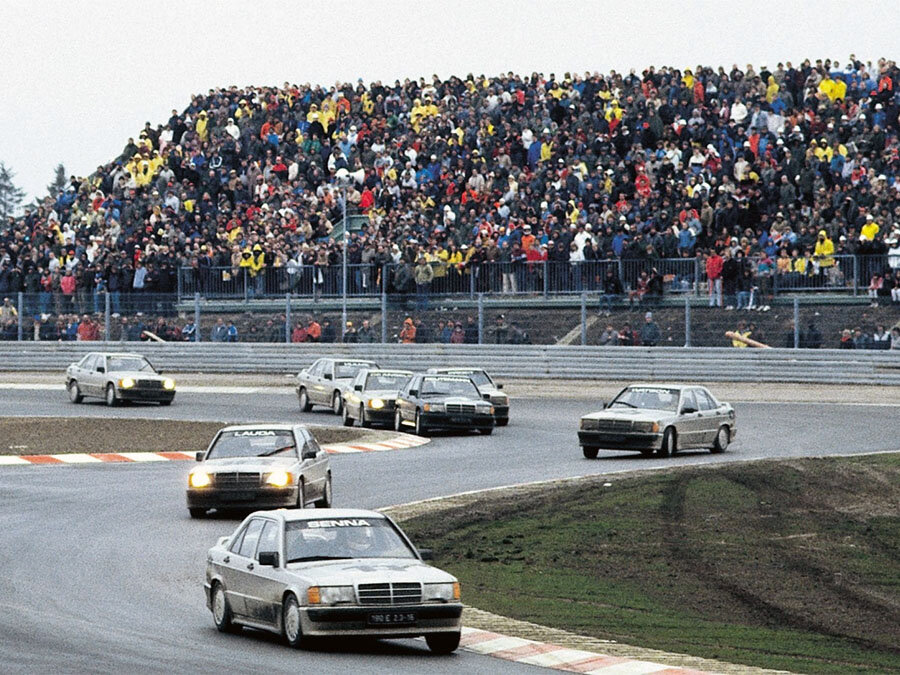Guide: Mercedes-Benz W201 190 E 2.3-16 - a Historical & Technical Appraisal
/BACKGROUND
In 1974, Mercedes-Benz management sanctioned the development of a new entry level model. It would be the firm’s first compact car and a rival for similar offerings from domestic rival, BMW.
Over the next few years, Mercedes spent a vast sum on research and development; the prototype W201 190 was subsequently approved for production in March 1979.
The finished car made its debut at the Paris Motor Show in October 1982 and production began in November. It was offered exclusively as a rear-wheel drive four-door Saloon.
Mercedes initially introduced the 190 with a choice of two-litre four cylinder engines: the carb-fed 190 or the more powerful 190 E which featured Bosch KE Jetronic fuel-injection.
Sales took off immediately and the 190 quickly established itself as the most desirable small Sedan on the market.
Although Mercedes had officially quit circuit racing at the end of the 1955 season, the company had unofficially given some back door support to AMG who wanted to race the W109 300 SEL V8 in the European Touring Car Championship. Equipped with a monster 6.8-litre engine, the big Mercedes most notably went on to take second place at the 1971 Spa 24 Hours.
More serious had been Mercedes occasional forays into long distance rallying. Several victories were claimed with production-based models over the years, most recently using the C107 450 SLC during 1978 and 1979.
It was this recent success on the special stages that inspired Mercedes to commission Cosworth Engineering in England to create a hot motor for a rally version of the 190 E.
It was initially thought a 320bhp engine plumbed into the W201 chassis would prove effective. However, this plan was soon abandoned owing to the proliferation of four-wheel drive machinery and the super specialised nature of the new Group B class cars which quickly began to dominate.
Despite no official plans for a factory competition programme, Mercedes nevertheless forged ahead with a Group A version of the 190 E.
Unlike Group B (which had a production requirement of just 200 cars in a twelve month timeframe), Group A had a 5000 car homologation threshold.
Group A would serve as the junior class for rallying and the premier category for Touring Car racing.
The new Mercedes-Benz 190 E 2.3-16 was launched at the Frankfurt Motor Show in September 1983.
Production began twelve months later.
CHASSIS
Each 2.3-16 was based on a standard 190 pressed steel bodyshell complete with 2665mm wheelbase.
At the front, the 190 had a MacPherson strut and separate spring arrangement. The back end used a five multi-link layout.
Anti-roll bars were fitted at either end along with anti-dive and anti-squat geometry.
For the 2.3-16, Mercedes fitted shorter and stiffer springs, firmer dampers, thicker anti-roll bars, harder bushings and a self-levelling rear axle. As a result, ride height was 15mm lower than normal at the front and 12mm lower at the rear.
Handling was further improved thanks to a quicker steering rack.
There were also special 7 x 15 Fuchs ‘Gullideckel’ alloy wheels that were both aerodynamically efficient and helped with brake cooling. These were originally shod with Pirelli P6 tyres.
Big new 284mm ventilated discs were fitted at the front and 258mm solid discs were installed at the back.
Unlike the standard 190 (which came with a 55-litre fuel cell), the 2.3-16 came with a 70-litre tank over the rear axle.
ENGINE / TRANSMISSION
At the heart of the 2.3-16 was an uprated version of the 2299cc inline four cylinder M 102 iron block engine used in the regular 190 E.
Most notably, the 2.3-16 featured a special light alloy cylinder head developed by Cosworth. Unlike the regular motor, it was equipped with dual overhead camshafts, four valves per cylinder and mechanical valve lifters. The valves were the largest that could possibly be fitted into the combustion chamber.
The heads were cast at Cosworth’s facility in Worcester and sent to Mercedes for installation.
In Germany, the Type M 102 E 23/2 motors were carefully assembled. Other special equipment included light pressed alloy pistons and rings designed to withstand higher engine speeds.
A wet-sump lubrication system was retained along with the Bosch KE fuel-injection system.
Displacement stayed at 2299cc thanks to a bore and stroke 95.5mm and 80.25mm respectively.
The compression ratio was hiked up to 10.5:1 and the 2.3-16 had to run exclusively on 98 RON fuel or better.
As a result of these changes, the power output went from 136bhp in the eight valve model to 185bhp at 6200rpm. The torque rating was 174lb-ft at 4500rpm.
Transmission was via a Getrag five-speed manual dog-leg gearbox (complete with oil cooler), a single plate clutch and limited-slip differential.
BODYWORK
The 190’s standard Bruno Sacco-designed bodywork was enhanced with a number of special features.
In typical fashion for a Mercedes of this era, Sacco had created the W201 range with restrained elegance in mind.
The 2.3-16 came with an integrated body kit that comprised a deep front spoiler and rear apron, side skirts, wheelarch extensions and a rear wing mounted on the boot lid.
As per the rest of the 190 range, the bumpers and different sized exterior mirrors were finished in satin black. Aside from the traditional Mercedes-Benz front grille, there was no brightwork to be found anywhere on the car.
INTERIOR
Special interior equipment included a small diameter leather steering wheel, a custom rev counter, a series of extra centre console-mounted gauges and more heavily bolstered sports seats.
Behind the four-spoke steering wheel was a curved instrument binnacle that was neatly integrated with the rest of the dash. A large speedometer was flanked to the right by a slightly smaller rev counter inset with an analogue clock. To the left was a combined gauge for fuel level, water temperature, oil pressure and fuel economy.
Two additional read outs (an ammeter, digital stop watch and oil temperature gauge) were housed in the centre console underneath the ventilation controls and audio system.
All cars came with a Zebrano wooden insert for the transmission console.
Black leather was used to upholster the seat bolsters. The seat centres were trimmed in checked fabric to match the door panels. A mix of hard-wearing soft-touch black plastic and vinyl was used pretty much everywhere else.
Individually contoured rear seats were unique to the 2.3-16.
As per many Mercedes of the 1970s and 1980s, the standard equipment level was quite basic – even electric windows were an optional extra.
OPTIONS
The 2.3-16 was available in just two colours: Blue-Black Metallic and Smoke Silver.
Myriad cost upgrades were also offered. They included ABS, leather upholstery, air-conditioning, electric windows (front only or front and rear), an electric sunroof, tinted glass, an outside temperature gauge, driver airbag, electric aerial, rear headrests, headlight wash/wipe, higher capacity battery and rear speakers.
Buyers could also specify electric front seats, electric front seats with memory function or electric heated seats.
One other optional extra was an Anti-Slip Differential (ASD). ASD was an electronically controlled, hydraulically locking differential that maximised traction. The electronic control allowed varied amounts of differential lock from the standard 15% right up to 100%. However, it was not a traction control system in that it did not prevent wheel spin. Activation of the ASD system was indicated by an illuminating amber triangle housed on the speedometer.
WEIGHT / PERFORMANCE
The 2.3-16 weighed in at 1350kg.
It had a top speed of 146mph and could hit 0-62mph in 7.2 seconds.
1983 NARDO SPEED RECORDS
Prior to the car’s original Frankfurt debut, Mercedes embarked on a series of speed record attempts. A 50,000km run was organised at Nardo in August 1983 to prove the car’s speed and reliability. Prior to this, Mercedes had tested extensively at the 12.6km Italian track in preparation.
The record run took place between August 13th and 21st. Three identical cars were on hand, all of which had been only slightly modified from the production specification.
Changes to the Nardo record cars included a long-range 160-litre fuel tank, ride height lowered by 15mm, the installation of self-levelling front suspension and addition of a lower front apron. To save weight, the engine fan and power steering assembly was removed. The gearbox was given a longer fifth gear ratio and reverse was removed entirely.
Three cars with six drivers each were used for the high speed test runs. They were set a target speed of 155mph. Each vehicle would return to the pits every 2.5 hours for a driver change and refuelling.
The nine day session proved a remarkable success. Although one of the cars was delayed by three hours, the other two cruised round to set three world records and nine international class records.
1984 GERMAN GP RACE OF CHAMPIONS
Another promotional event took place four months prior to production starting in May 1984.
It was held at the brand new Nurburgring Grand Prix Course which was playing host to the 1984 German Formula 1 GP.
In support of the main event, Mercedes convinced 20 top drivers to contest a twelve lap ‘Race of Champions’.
Drivers present included former F1 champions Niki Lauda, Keke Rosberg, Alan Jones, James Hunt, Jody Scheckter, Phil Hill, Jack Brabham, John Surtees and Denny Hulme. Stirling Moss was also on hand along with Carlos Reutemann, John Watson, Klaus Ludwig, Manfred Schurti, Jacques Laffite, Udo Schutz, Hans Herrmann, Elio de Angelis, Alain Prost and Ayrton Senna.
The only living F1 champions missing from the contest were Nelson Piquet and Jackie Stewart whose respective employers would not give them clearance to participate. Emerson Fittipaldi and Mario Andretti were busy pre-qualifying for the Indy 500. Juan Manuel Fangio was in attendance but did not race for health reasons.
The 21 identical cars were prepared with a shorter final drive, un-silenced exhausts, stiffer springs and shocks (which lowered the ride height by 15mm), increased wheel offset for 20mm wider track, four-piston brake calipers, Pirelli P7 tyres, a larger diameter steering wheel and quick-release safety pins for the hood.
There was also essential safety equipment such as a roll cage, fire extinguisher and battery cut-off switch.
Each car was fitted with an electric driver’s seat.
Qualifying saw Prost on pole with Reutemann, Senna, Hulme, Jones, Watson, de Angelis, Schurti, Surtees and Hill closing out the rest of the top ten.
In the race, Senna moved up to second and then forced Prost off track half way round the opening lap. The Brazilian took a lead he would not relinquish.
Niki Lauda (who had missed most of practice owing to TV commitments) rose from 14th on the grid to take the runner’s up spot, some 1.38 seconds behind Senna. The rest of the top six comprised Reutemann in third, Rosberg in fourth, Watson fifth and Hulme sixth.
Senna’s winning car was retained by Mercedes. Lauda’s was sold off in race trim. The others were reconfigured as road cars and sold to meet the tremendous demand for the model.
PRODUCTION CHANGES
During the course of the 2.3-16’s production life, several technical changes were made.
Very early cars differed from subsequent examples on account of their twin blade wiper arm on the right instead of a large single wiper on the left. These cars also came with a grooved rear apron and slightly different hood.
In 1985, Mercedes added a four-speed automatic gearbox to the options list along with self-levelling front suspension.
In 1986, two new engine options were introduced, both of which used the existing type number (M 102 E 23/2).
The KAT engine featured a catalytic converter and 9.7:1 compression ratio. Peak output was 170bhp at 5800rpm and 162lb-ft at 4750rpm. Top speed was 138mph and 0-62mph dropped to 7.8 seconds.
The availability of the KAT engine enabled Mercedes to sell the 2.3-16 in the USA. US versions were only available throughout 1986 and 1987. In addition to the KAT engine, they also featured a lower redline (6800rpm instead of 7200rpm), a lower rear axle ratio, different headlights, a third brake light, extra side impact protection and a wooden dash insert.
The RUF engine was an unleaded fuel version without a catalytic converter. Like the KAT version, compression was 9.7:1 instead of 10.5:1. However, peak output was a little higher: 177bhp at 5800rpm and 170lb-ft at 4750rpm. Top speed was 141mph and 0-62mph took 7.7 seconds.
Unlike the regular 2.3-16 engine which required 98 RON fuel, the KAT and RUF versions could run on 95 RON petrol.
In 1987, the previously optional ASD system was added to the list of standard equipment.
END OF PRODUCTION
Mercedes produced the 2.3-16 until June 1988. By this time, 19,487 had been completed. Of these, 600 were right-hand drive.
In September 1988, Mercedes introduced a long stroke 2.5-litre version (covered separately).
Text copyright: Supercar Nostalgia
Photo copyright: Mercedes-Benz - https://www.mercedes-benz.com








































